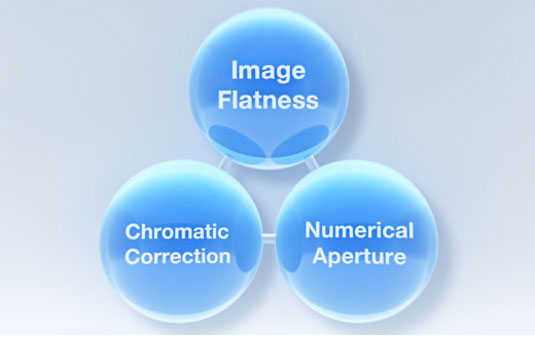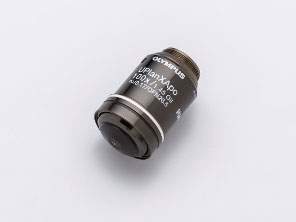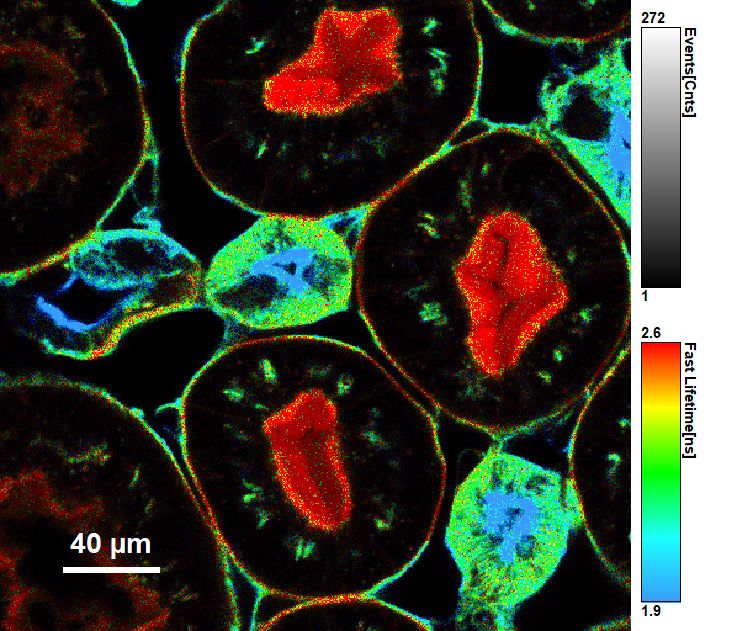Since its launch in 2019, X Line objectives have been the flagship of our life science objectives range—forming the heart of many of our high-end imaging systems. But their success doesn’t stop there. These award-winning optics have also been integrated into many cutting-edge microscopy systems designed outside of Olympus.
One example is a confocal microscope system designed by PicoQuant.
PicoQuant is a leading supplier of advanced imaging equipment, such as pulsed diode lasers and time-resolved data acquisition, single-photon counting, and fluorescence instruments. Their focus lies in developing highly sensitive, modular, and easy-to-use systems to support researchers in biology, physics, material sciences, and chemistry.
As part of a long-standing collaboration with Olympus, PicoQuant tested out the X Line objectives in their MicroTime 200 time-resolved confocal microscope. This system, shown in Figure 1, provides single-molecule sensitivity and picosecond temporal resolution.

Figure 1. The PicoQuant MicroTime 200 time-resolved confocal microscope provides single-molecule sensitivity for cutting-edge scientific studies.
How X Line Optics Improve the Performance of Advanced Imaging Systems
X Line objectives bring a unique benefit to advanced microscope systems by providing simultaneous improvements in three critical areas—numerical aperture, image flatness, and chromatic correction. With conventional objectives, an improvement in one of these parameters often leads to a deterioration in the others. Thanks to our award-winning lens manufacturing technique (Figure 2), these tradeoffs are now a thing of the past.

Figure 2. Olympus X Line objectives avoid the typical tradeoff between image flatness, chromatic correction, and numerical aperture.
Dr. Marcelle König, Senior Scientist at PicoQuant, explained how the performance of X Line objectives enhances their confocal microscope design.
“One key technique for our customers is pulsed interleaved excitation (PIE). It uses synchronized pulsed lasers of different wavelengths for the quasi-simultaneous excitation of different fluorophores within the confocal sample volume, so avoiding chromatic shifts is critical. To test the X Line objectives, we looked at fluorescent beads excited with 485 nm (blue) and 640 nm (red) lasers. We then measured the beads simultaneously using the PIE approach to check the shift, and the results were very convincing—the new objectives really are better for avoiding chromatic shifts in all three dimensions,” said Marcelle.
Marcelle continued, “The enhanced numerical aperture is also beneficial because the MicroTime 200 has single-molecule sensitivity, so the more photons you can get out of your sample, the better. An example for single-molecule applications is Förster resonance energy transfer—or FRET. This is a prominent technique in biology, and the combination with the PIE approach is highly beneficial for single-molecule FRET studies.”
After the successful trial run, PicoQuant officially implemented Olympus’ X Line objective lens in their MicroTime 200 systems. The most commonly used objective for this application is the 100X oil immersion lens (UPLXAPO100XO), which has a numerical aperture of 1.45 (Figure 3).

Figure 3. The Olympus X Line 100X oil immersion lens.
Advancing Science through Collaboration
Marcelle also noted the strong collaboration between Olympus and PicoQuant.
To find out more about Olympus’ high-quality OEM optics, components, frames, and parts to integrate into your microscope designs, please visit www.olympus-lifescience.com/oem-components.
Related Content
3 Advantages of Using X Line Objectives
Why Objectives with Wavefront Aberration Control Are Essential for Good Microscope Design

